Here's what you can expect from this answer:

Also note that the code provided here was written for test purposes, and thus isn't optimized.
I have used Animator (available for api >= 11) to achieve the effect you have described as I don't find TranslateAnimation and ScaleAnimation 'good' enough in terms of outcome.
There are 3 things happening here:
- width is changing
- height is changing
- 'x' value for the imageview is changing
You will need to provide the final values for these 3 parameters: finalWidth, finalHeight and final X placement.
We will use valueAnimator to get animated values for the width and height on every update, and then use these values to update the LayoutParams of ImageView.
The animate button (in the gif above) calls the following method:
public void animate() {
// This is to get the screen dimensions
final Point p = new Point();
getWindowManager().getDefaultDisplay().getSize(p);
// First, define the starting values
final int startingWidth = mImageView.getWidth();
final int startingHeight = mImageView.getHeight();
final int startingXValue = mImageView.getX():
// Next, define the final values
// For this example, the final width will be half of screen-width
final int finalWidth = p.x / 2;
// Just an arbitrary final value for height. You will have to decide
// what the final height should be
final int finalHeight = p.y - ivv.getTop() - 300;
// final `X` placement of the imageview
int finalXValue = p.x / 2 - finalWidth / 2;
// ValueAnimator to generate changes in width
final ValueAnimator vaW = ValueAnimator.ofInt(startingWidth, finalWidth);
vaW.addUpdateListener(new AnimatorUpdateListener() {
@Override
public void onAnimationUpdate(ValueAnimator animation) {
// Get animated width value update
int newWidth = (int) vaW.getAnimatedValue();
// Get and update LayoutParams from imageview
LinearLayout.LayoutParams lp = (LinearLayout.LayoutParams)
mImageView.getLayoutParams();
lp.width = newWidth;
mImageView.setLayoutParams(lp);
}
});
// ValueAnimator to generate changes in height
final ValueAnimator vaH = ValueAnimator.ofInt(startingHeight, finalHeight);
vaW.addUpdateListener(new AnimatorUpdateListener() {
@Override
public void onAnimationUpdate(ValueAnimator animation) {
// Get animated height value update
int newHeight = (int) vaH.getAnimatedValue();
// Get and update LayoutParams from imageview
LinearLayout.LayoutParams lp = (LinearLayout.LayoutParams)
mImageView.getLayoutParams();
lp.height = newHeight;
mImageView.setLayoutParams(lp);
}
});
// Used to provide translate animation
ObjectAnimator oa = ObjectAnimator.ofFloat(
mImageView, "X", startingXValue,
finalXValue);
// To play these 3 animators together
AnimatorSet as = new AnimatorSet();
as.playTogether(vaW, vaH, oa);
as.setDuration(5000);
as.start();
}
The layout used for the activity in this example is nothing special:
<LinearLayout xmlns:android="http://schemas.android.com/apk/res/android"
android:layout_width="match_parent"
android:layout_height="match_parent"
android:orientation="vertical"
android:background="@android:color/holo_blue_dark" >
<Button
android:id="@+id/bAnimate"
android:layout_width="wrap_content"
android:layout_height="wrap_content"
android:text="animate"
android:layout_gravity="center_horizontal" />
<ImageView
android:id="@+id/ivToAnimate"
android:layout_width="100dp"
android:layout_height="100dp"
android:text="animate"
android:layout_gravity="right"
android:src="@drawable/index"
android:scaleType="centerCrop" />
</LinearLayout>
Edit: To reset ImageView's position, size & scale:
Declare starting and final values as class variables:
int startingWidth, startingHeight, startingXValue,
finalWidth, finalHeight, finalXValue;
// this method will only be called ONCE.
// Use appropriate values to initialize starting and final values
public void initialize() {
final Point p = new Point();
getWindowManager().getDefaultDisplay().getSize(p);
startingWidth = mImageView.getWidth();
startingHeight = mImageView.getHeight();
startingXValue = mImageView.getX():
finalWidth = p.x / 2;
finalHeight = p.y - ivv.getTop() - 300;
finalXValue = p.x / 2 - finalWidth / 2;
}
// Call this method whenever you need to animate forward
// `animate()` method // refer above for comments
public void animate() {
final ValueAnimator vaW = ValueAnimator.ofInt(startingWidth, finalWidth);
vaW.addUpdateListener(new AnimatorUpdateListener() {
@Override
public void onAnimationUpdate(ValueAnimator animation) {
int newWidth = (int) vaW.getAnimatedValue();
LinearLayout.LayoutParams lp = (LinearLayout.LayoutParams)
mImageView.getLayoutParams();
lp.width = newWidth;
mImageView.setLayoutParams(lp);
}
});
final ValueAnimator vaH = ValueAnimator.ofInt(startingHeight, finalHeight);
vaW.addUpdateListener(new AnimatorUpdateListener() {
@Override
public void onAnimationUpdate(ValueAnimator animation) {
int newHeight = (int) vaH.getAnimatedValue();
LinearLayout.LayoutParams lp = (LinearLayout.LayoutParams)
mImageView.getLayoutParams();
lp.height = newHeight;
mImageView.setLayoutParams(lp);
}
});
ObjectAnimator oa = ObjectAnimator.ofFloat(
mImageView, "X", startingXValue,
finalXValue);
AnimatorSet as = new AnimatorSet();
as.playTogether(vaW, vaH, oa);
as.setDuration(5000);
as.start();
}
Animate back:
// `animateBack()` method // similar execution to `animate()`
// Notice how the starting and final values have been switched
public void animateBack() {
final ValueAnimator vaW = ValueAnimator.ofInt(finalWidth, startingWidth);
vaW.addUpdateListener(new AnimatorUpdateListener() {
@Override
public void onAnimationUpdate(ValueAnimator animation) {
int newWidth = (int) vaW.getAnimatedValue();
LinearLayout.LayoutParams lp = (LinearLayout.LayoutParams)
mImageView.getLayoutParams();
lp.width = newWidth;
mImageView.setLayoutParams(lp);
}
});
final ValueAnimator vaH = ValueAnimator.ofInt(finalHeight, startingHeight);
vaW.addUpdateListener(new AnimatorUpdateListener() {
@Override
public void onAnimationUpdate(ValueAnimator animation) {
int newHeight = (int) vaH.getAnimatedValue();
LinearLayout.LayoutParams lp = (LinearLayout.LayoutParams)
mImageView.getLayoutParams();
lp.height = newHeight;
mImageView.setLayoutParams(lp);
}
});
ObjectAnimator oa = ObjectAnimator.ofFloat(
mImageView, "X", finalXValue, startingXValue);
AnimatorSet as = new AnimatorSet();
as.playTogether(vaW, vaH, oa);
as.setDuration(5000);
as.start();
}




